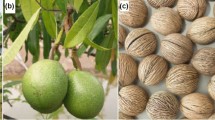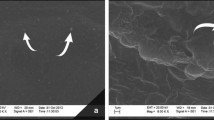Abstract
In this study, UV cured bio-nanocomposite coating systems were developed. An acrylated epoxidized soybean oil (AESO) and cellulose nanocrystals (CNCs) were used to make these coating systems. The CNC surface was modified by two different methods so as to achieve good compatibility between the CNC and AESO. Thermal stability, glass transition temperature, optical clarity (transparency), and curing behavior of the coating systems were assessed. The addition of CNC altered the thermal stability of the bio-nanocomposites slightly. Addition of CNC increased glass transition temperature of AESO. This increase was a function of the CNC surface modification method and CNC loading level. The transparency of the bio-nanocomposites was reduced by the addition of CNC. The curing behavior of these coating systems was not significantly different from that of a pure cured AESO matrix. A study of the morphology of the nanocomposite films by AFM demonstrated that the modified CNC had good compatibility with the AESO matrix.





Similar content being viewed by others
References
Meier, MAR, Metzger, JO, Schubert, US, “Plant Oil Renewable Resources as Green Alternatives in Polymer Science.” Chem. Soc. Rev., 36 (11) 1788–1802 (2007)
Biermann, U, Friedt, W, Lang, S, Lühs, W, Machmüller, G, Metzger, JO, Rüsch Gen Klaas, M, Schäfer, HJ, Schneider, MP, “New Syntheses with Oils and Fats as Renewable Raw Materials for the Chemical Industry.” In: Kamm, B, Gruber, PR, Kamm, M (eds.) Biorefineries-Industrial Processes and Products: Status Quo and Future Directions, pp. 253–289. Wiley-VCH, Weinheim (2005)
Hilker, I, Bothe, D, Pruss, J, Warnecke, H-J, “Chemo-Enzymatic Epoxidation of Unsaturated Plant Oils.” Chem. Eng. Sci., 56 (2) 427–432 (2001)
La Scala, JJ, Sands, JM, Orlicki, JA, Robinette, EJ, Palmese, GR, “Fatty Acid-Based Monomers as Styrene Replacements for Liquid Molding Resins.” Polymer, 45 (22) 7729–7737 (2004)
Islam, MR, Beg, MDH, Jamari, SS, “Development of Vegetable-Oil-Based Polymers.” J. Appl. Polym. Sci., 131 (18) 40787 (2014)
Guner, FS, Yagci, Y, Erciyes, AT, “Polymers from Triglyceride Oils.” Prog. Polym. Sci., 31 (7) 633–670 (2006)
Remeikyte, A, Ostrauskaite, J, Grazuleviciene, V, “Synthesis and Properties of Photocross-Linked Polymers of Epoxidized Linseed Oil with Different Reactive Diluents.” J. Appl. Polym. Sci., 129 (3) 1290–1298 (2013)
Saithai, P, Lecomte, J, Dubreucq, E, Tanrattanakul, V, “Effects of Different Epoxidation Methods of Soybean Oil on the Characteristics of Acrylated Epoxidized Soybean Oil-co-Poly(Methyl Methacrylate) Copolymer.” Express Polym. Lett., 7 (11) 910–924 (2013)
Borugadda, VB, Goud, VV, “Epoxidation of Castor Oil Fatty Acid Methyl Esters (COFAME) as a Lubricant Base Stock Using Heterogeneous Ion-Exchange Resin (IR-120) as a Catalyst.” Energy Proc., 54 75–84 (2014)
Somidi, AKR, Sharma, RV, Dalai, AK, “Synthesis of Epoxidized Canola Oil Using a Sulfated-SnO2 Catalyst.” Ind. Eng. Chem. Res., 53 (49) 18668–18677 (2014)
Fehr, WR, “Soybean.” In: Robbelen, G, Downey, RK, Ashri, A (eds.) Oil Crops of the World: Their Breeding and Utilization, pp. 283–300. McGraw-Hill Publishing Company, New York (1989)
Gunstone, FD, “Industrial Uses of Soybean Oil for Tomorrow.” In: Special Report’96. Iowa State University and the Iowa Soybean Promotion Board (1995)
Jin, F-L, Park, S-J, “Thermal and Rheological Properties of Vegetable Oil-Based Epoxy Resins Cured with Thermal Latent Initiator.” J. Ind. Eng. Chem., 13 808–814 (2007)
Gupta, AP, Ahmad, S, Dev, A, “Development of Novel Bio-Based Soybean Oil Epoxy Resins as a Function of Hardener Stoichiometry.” Polym. Plast. Technol., 49 657–661 (2010)
Ortiz, RA, López, DP, Cisneros, MLG, Valverde, JCR, Crivello, JV, “A Kinetic Study of the Acceleration Effect of Substituted Benzyl Alcohols on the Cationic Photopolymerization Rate of Epoxidized Natural Oils.” Polymer, 46 (5) 1535–1541 (2005)
Lu, J, Hong, CK, Wool, RP, “Bio-Based Nanocomposites from Functionalized Plant Oils and Layered Silicate.” J. Polym. Sci. Part B Polym. Phys., 42 (8) 1441–1450 (2004)
Uyama, H, Kuwabara, M, Tsujimoto, T, Nakano, M, Usuki, A, Kobayashi, S, “Green Nanocomposites from Renewable Resources: Plant Oil–Clay Hybrid Materials.” Chem. Mater., 15 (13) 2492–2494 (2003)
Uyama, H, Kuwabara, M, Tsujimoto, T, Nakano, M, Usuki, A, Kobayashi, S, “Organic–Inorganic Hybrids from Renewable Plant Oils and Clay.” Macromol. Biosci., 4 (3) 354–360 (2004)
Miyagawa, H, Misra, M, Drzal, LT, Mohanty, AK, “Novel Biobased Nanocomposites from Functionalized Vegetable Oil and Organically-Modified Layered Silicate Clay.” Polymer, 46 (2) 445–453 (2005)
Hietala, M, Mathew, AP, Oksman, K, “Bionanocomposites of Thermoplastic Starch and Cellulose Nanofibers Manufactured Using Twin-Screw Extrusion.” Eur. Polym. J., 49 (4) 950–956 (2013)
Samir, MASA, Alloin, F, Dufresne, A, “Review of Recent Research Into Cellulosic Whiskers, Their Properties and Their Application in Nanocomposite Field.” Biomacromolecules, 6 (2) 612–626 (2005)
Grunert, M, Winter, WT, “Nanocomposites of Cellulose Acetate Butyrate Reinforced with Cellulose Nanocrystals.” J. Polym. Environ., 10 (1–2) 27–30 (2002)
Dufresne, A, Kellerhals, MB, Witholt, B, “Transcrystallization in Mcl-PHAs/Cellulose Whiskers Composites.” Macromolecules, 32 (22) 7396–7401 (1999)
Oksman, K, Mathew, AP, Bondeson, D, Kvien, I, “Manufacturing Process of Cellulose Whiskers/Polylactic Acid Nanocomposite.” Compos. Sci. Technol., 66 (15) 2776–2784 (2006)
Noishiki, Y, Nishiyama, Y, Wada, M, Kuga, S, Magoshi, J, “Mechanical Properties of Silk Fibroin-Microcrystalline Cellulose Composite Films.” J. Appl. Polym. Sci., 86 (13) 3425–3429 (2002)
Anglès, MN, Dufresne, A, “Plasticized Starch/Tunicin Whiskers Nanocomposite Materials. 2. Mechanical Behavior.” Macromolecules, 34 (9) 2921–2931 (2001)
George, J, Sabapathi, S, “Cellulose Nanocrystals: Synthesis, Functional Properties, and Applications.” Nanotechnol. Sci. Appl., 8 45–54 (2015)
Habibi, Y, Lucia, LA, Rojas, OJ, “Cellulose Nanocrystals: Chemistry, Self-assembly, and Applications.” Chem. Rev., 110 (6) 3479–3500 (2010)
Eyley, S, Thielemans, W, “Surface Modification of Cellulose Nanocrystals.” Nanoscale, 6 (14) 7764–7779 (2014)
Abraham, E, Kam, D, Nevo, Y, Slattegard, R, Rivkin, A, Lapidot, S, Shoseyov, O, “Highly Modified Cellulose Nanocrystals and Formation of Epoxy-Nanocrystalline Cellulose (CNC) Nanocomposites.” ACS Appl. Mater. Interfaces, 8 (41) 28086–28095 (2016)
Kaboorani, A, Riedl, B, “Surface Modification of Cellulose Nanocrystal (CNC) by a Cationic Surfactant.” Ind. Crop. Prod., 65 45–55 (2015)
Vardanyan, V, Poaty, B, Landry, V, Chauve, G, Galstian, T, Riedl, B, “Wear Resistance of Nanocomposite Coatings.” In: Aliofkhazraei, M (ed.) Anti-Abrasive Nanocoatings: Current and Future Applications, pp. 201–223. Woodhead Publishing, Cambridge (2015)
Connors, KA, Pandit, NK, “N-Methylimidazole as a Catalyst for Analytical Acetylations of Hydroxyl Compounds.” Anal. Chem., 50 (11) 1542–1545 (1978)
Poaty, B, Vardanyan, V, Wilczak, L, Chauve, G, Riedl, B, “Modification of Cellulose Nanocrystals as Reinforcement Derivatives for Wood Coatings.” Prog. Org. Coat., 77 (4) 813–820 (2014)
Scott, TF, Cook, WD, Forsythe, JS, “Photo-DSC Cure Kinetics of Vinyl Ester Resins. I. Influence of Temperature.” Polymer, 43 (22) 5839–5845 (2002)
Scott, TF, Cook, WD, Forsythe, JS, “Photo-DSC Cure Kinetics of Vinyl Ester Resins II: Influence of Diluent Concentration.” Polymer, 44 (3) 671–680 (2003)
Sow, C, Riedl, B, Blanchet, P, “Kinetic Studies of UV-Waterborne Nanocomposite Formulations with Nanoalumina and Nanosilica.” Prog. Org. Coat., 67 (2) 188–194 (2010)
Landry, V, Riedl, B, Blanchet, P, “Nanoclay Dispersion Effects on UV Coatings Curing.” Prog. Org. Coat., 62 (4) 400–408 (2008)
Cho, MJ, Park, BD, “Tensile and Thermal Properties of Nanocellulose-Reinforced Poly(Vinyl Alcohol) Nanocomposites.” J. Ind. Eng. Chem., 17 (1) 36–40 (2011)
Sousa, AF, Ferreira, S, Lopez, A, Borges, I, Pinto, RJB, Silvestre, AJD, Freire, CSR, “Thermosetting AESO-Bacterial Cellulose Nanocomposite Foams with Tailored Mechanical Properties Obtained by Pickering Emulsion Templating.” Polymer, 118 127–134 (2017)
Casado, U, Marcovich, NE, Aranguren, MI, Mosiewicki, MA, “High-Strength Composites Based on Tung Oil Polyurethane and Wood Flour: Effect of the Filler Concentration on the Mechanical Properties.” Polym. Eng. Sci., 49 (4) 713–721 (2009)
Mosiewicki, MA, Casado, U, Marcovich, NE, Aranguren, MI, “Polyurethanes from Tung Oil: Polymer Characterization and Composites.” Polym. Eng. Sci., 49 (4) 685–692 (2009)
Wik, VM, Aranguren, MI, Mosiewicki, MA, “Castor Oil-Based Polyurethanes Containing Cellulose Nanocrystals.” Polym. Eng. Sci., 51 (7) 1389–1396 (2011)
Mosiewicki, MA, Wik, VM, Aranguren, MI, “Environmentally Friendly Polymer Composites Prepared with Cellulose Nanocrystals.” Society of Plastics Engineers. http://www.4spepro.org (2011)
Ivdre, A, Mucci, V, Stefani, PM, Aranguren, MI, Cabulis, U, “Nanocellulose Reinforced Polyurethane Obtained from Hydroxylated Soybean Oil.” IOP Conf. Ser. Mater. Sci. Eng., 111 12 (2016)
Azeredo, HMC, Mattoso, LHC, Avena-Bustillos, RJ, Filho, GC, Munford, ML, Wood, D, McHugh, TH, “Nanocellulose Reinforced Chitosan Composite Films as Affected by Nanofiller Loading and Plasticizer Content.” J. Food Sci., 75 (1) N1–N7 (2010)
Ansari, F, Galland, S, Johansson, M, Plummer, CJG, Berglund, LA, “Cellulose Nanofiber Network for Moisture Stable, Strong and Ductile Biocomposites and Increased Epoxy Curing Rate.” Compos. Part A Appl. Sci. Manuf., 63 35–44 (2014)
Novak, BM, “Hybrid Nanocomposite Materials-Between Inorganic Glasses and Organic Polymers.” Adv. Mater., 5 (6) 422–433 (1993)
Nguegang Nkeuwa, W, Riedl, B, Landry, V, “UV-Cured Clay/Based Nanocomposite Topcoats for Wood Furniture: Part I: Morphological Study, Water Vapor Transmission Rate and Optical Clarity.” Prog. Org. Coat., 77 (1) 1–11 (2014)
Iwamoto, S, Nakagaito, AN, Yano, H, “Nano-Fibrillation of Pulp Fibers for the Processing of Transparent Nanocomposites.” Appl. Phys. A Mater., 89 (2) 461–466 (2007)
Kaboorani, A, Riedl, B, Blanchet, P, Fellin, M, Hosseinaei, O, Wang, S, “Nanocrystalline Cellulose (NCC): A Renewable Nano-Material for Wood Adhesives.” Eur. Polym. J., 48 1829–1837 (2012)
Acknowledgments
The authors would like to thank the Natural Sciences and Engineering Research Council of Canada (NSERC) for funding this research. The thanks are also extended to Centre de recherche sur les matériaux renouvelables (CRMR) (Quebec, QC, Canada) and FPInnovations (Quebec, QC, Canada) for their technical support.
Author information
Authors and Affiliations
Corresponding author
Additional information
Publisher's Note
Springer Nature remains neutral with regard to jurisdictional claims in published maps and institutional affiliations.
Rights and permissions
About this article
Cite this article
Auclair, N., Kaboorani, A., Riedl, B. et al. Effects of surface modification of cellulose nanocrystals (CNCs) on curing behavior, optical, and thermal properties of soybean oil bio-nanocomposite. J Coat Technol Res 17, 57–67 (2020). https://doi.org/10.1007/s11998-019-00237-y
Published:
Issue Date:
DOI: https://doi.org/10.1007/s11998-019-00237-y




